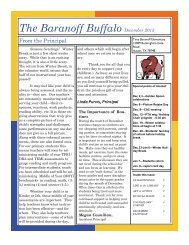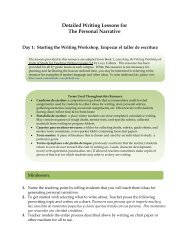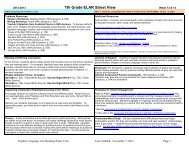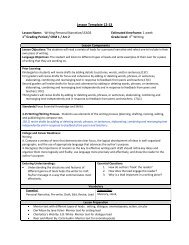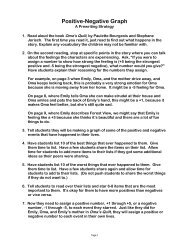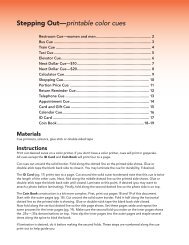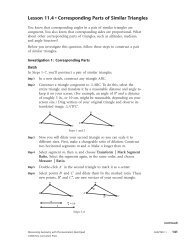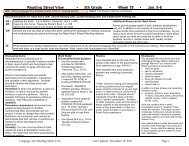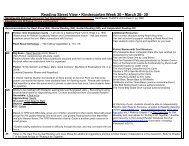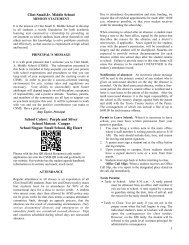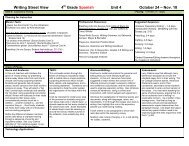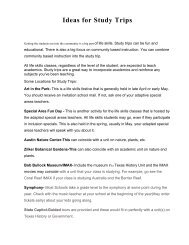Writing Street View 4th Grade Unit 6 January 7 25, 2013 - Office of ...
Writing Street View 4th Grade Unit 6 January 7 25, 2013 - Office of ...
Writing Street View 4th Grade Unit 6 January 7 25, 2013 - Office of ...
Create successful ePaper yourself
Turn your PDF publications into a flip-book with our unique Google optimized e-Paper software.
<strong>Writing</strong> <strong>Street</strong> <strong>View</strong> 4 th <strong>Grade</strong> <strong>Unit</strong> 7 <strong>January</strong> 28 – February 22, <strong>2013</strong><strong>Unit</strong> 7: <strong>Writing</strong> PoetryPacing: 3 WeeksPlanning for InstructionMentor Texts:Haiku Hike by written and illustrated by fourth-gradestudents <strong>of</strong> St. Mary's Catholic School in Mansfield,Massachusetts (Scholastic, 2005)Where The Sidewalk Ends by Shel SilversteinLove That Dog By Sharon CreechOut <strong>of</strong> the Dust By Karen HesseI Never Saw Another Butterfly by Hana VolavkovaYo! Yes! by Chris RaschkaSpeak to Me by Karen English and Amy June BatesMarvelous Math: a book <strong>of</strong> poems by Lee Bennett HopkinsWonderful Words selected by Lee Bennett HopkinsSpectacular Science by Lee Bennett HopkinsTurtle In July by Marilyn SingerPirates by David Harrison (Bluebonnet Book 2010)Poems from Treasures reading textbookPoems from Treasures Read Aloud AnthologyPoems from Treasures Time For KidsPr<strong>of</strong>essional Resources:Guiding Readers and Writers, <strong>Grade</strong>s 3-6,Irene C. Fountas and Gay Su Pinnell (Chapter 24)No-Nonsense Guide to Teaching <strong>Writing</strong>,Judy Davis and Sharon HillTreasures Phonics/Spelling Practice Book(Resource CD),Macmillan/McGraw-HillTexas Write Source,Houghton MifflinHarcourt PublishingSuggested Sequence:Because children must first, spend time reading poetry tounderstand it, analyze it, and become inspired to write poetry,at the start <strong>of</strong> this unit, you will spend a few days prewriting forpoetry in this way. As students begin to draft poetry, they doproceed through all stages <strong>of</strong> the writing process, but becausemany poems are short, they may move through the processvery quickly, sometimes completing more than one poem inone writing period. In any case, you should continue to modeleach stage <strong>of</strong> the writing process, especially revising to showthat poetry, like all other writing, is revised or rewritten severaltimes in an attempt to create just the right picture or feeling inthe reader’s mind. While editing, be sure to model for studentshow to experiment with the visual placement <strong>of</strong> words,capitalization and punctuation, to achieve specific visual effectsin their poems.See “Getting Started with Poetry Workshop”, in the Organizingsection below, for suggestions on how to structure the writingprocess for poetry.Areas <strong>of</strong> FocusGenre and Audience:Poetry is generally written to entertain. Somepoetry is humorous; some is serious. Somepoetry describes; some tells a story. Manypoems make the reader think about ideas innew ways or from new perspectives.“Poetry brings together sounds and words inunique, intriguing ways that may evoke intenseimagery and pr<strong>of</strong>ound meaning. The best poetryfrequently contains an element <strong>of</strong> surprise. Youencounter language that you want to read overand over, and when you do, you experience thepoem anew each time. Your thoughts andemotions may be aroused by a single word.”(Fountas & Pinnell)Most poems are enjoyed best when we readthem aloud, because we can appreciate themusical sound, the rhythm, and the imagery <strong>of</strong>the language. If possible, we recommend thatyou take the poetry written by children to anaudience outside the school environment,where the creative work <strong>of</strong> the children will begenuinely appreciated and celebrated.TEKS:The Student Expectation forwriting poetry says that studentsshould be writing poems that‘convey sensory details’ andinclude:• Rhyme• Meter• Patterns <strong>of</strong> verse• Alliteration• Onomatopoeia• Similes• Metaphors• Graphic ElementsWithin this unit we also want toteach the Student Expectation forreading poetry, specifically thecharacteristics <strong>of</strong> various forms <strong>of</strong>poetry, such as narrative poetry,lyrical poetry, humorous poetry, freeverse, etc.Grammar/Editing:If you have kept up with teachingthe conventions SEs as outlined inthe previous CRMs, all grammarand editing skills have alreadybeen taught. Please consult the<strong>4th</strong> <strong>Grade</strong> ConventionsChecklist to make sure yourstudents have been taught andare reviewing all the parts <strong>of</strong>speech, capitalization,punctuation, and spelling SEs thatneed to be mastered for theSTAAR <strong>Writing</strong> Assessment.Assessment:Students will not be asked to write poetry for theSTAAR <strong>Writing</strong> test at any grade level. However,the STAAR Reading tests at all grade levels willinclude comprehension, analysis, and somemechanical knowledge <strong>of</strong> the form and structuresused in poetry.It can be argued that a person does not trulyunderstand the intricacies <strong>of</strong> poetry until he haswritten poetry. And because there are so manydifferent forms <strong>of</strong> poetry, children will not gain anoverall knowledge <strong>of</strong> the many different kinds <strong>of</strong>poetry until they have spent a considerableamount <strong>of</strong> time reading a variety <strong>of</strong> poetry,analyzing it, talking about it, listening to differentperspectives on it, and ultimately trying to writemany different kinds <strong>of</strong> poetry. Students continueto work on refining word choice by choosingprecise wording for the poems they write.It is worth our time to ask children to try writingpoetry, even if we are not completely comfortablewith writing it ourselves. Most children enjoy thechallenge and, at the very least, they will not beafraid <strong>of</strong> it when they see it on their reading test.
Prewriting:<strong>Writing</strong> Process: <strong>Writing</strong> Poetry – Attachments for Poetry (in green) can be found here.Immerse your students in the sound and imagery <strong>of</strong> poetry, to teach them to enjoy readingpoetry, prior to asking them to write poetry. Reading Poetry Aloud (for teachers)Have Students Respond to PoetryHave Students Read Poetry AloudGenerating Ideas for Free Verse Poetry – Using 12x18 paper, show students how to fold thepaper into six squares. Have students label each square with the words: See, Hear,Smell, Taste, Feel, Feelings. Model how to brainstorm ideas foreach square to describe your topic. These words and phrases maythen be used to create lines <strong>of</strong> poetry for your topic. See theseexamples. State Fair Organizer, State Fair PoemGraphic Organizer: Free Verse Poem – another suggestion for generating ideasThe Word Box – an exercise that promotes the idea <strong>of</strong> playing with words.Final Draft/Publishing:Conferencing:Designate one wall in a centrally located corridor asyour school “poetry gallery.” Change the theme everymonth to feature nature poems, poems from differentcultures, poems by a particular poet, and so forth.Invite students to add poems they have selected,copied, and illustrated, or poems they have written andillustrated themselves. (Fountas and Pinnell, p. 418)Send illustrated poems (written around a theme, suchas Lady Bird Lake, Zilker Park, Austin SymphonyOrchestra, etc.) to the appropriate managing <strong>of</strong>fice.You could do this for one <strong>of</strong> your school’s adopters.World Poetry Day is March 21, and April is NationalPoetry Month. Ask your local library if they will displayyour students’ poems in celebration <strong>of</strong> these events.Editing:Organizing and Drafting are <strong>of</strong>ten interchangeable processes during thewriting <strong>of</strong> poetry:Vocabulary List – As you introduce your students to different types <strong>of</strong> poetry,gradually introduce the vocabulary <strong>of</strong> poetry. Model for students how you use yourWriters Notebook to find topics for your next poems.Getting Started with Poetry WorkshopA Suggested Sequence for Teaching Different Forms <strong>of</strong> PoetryAnalyze a poem to Write a poemWhile conferencing with your students, you will help themreflect on their poems and learn to revise them. Inviteyour students to read their poem aloud to you. If it feelscluttered or disjointed or has less interesting parts, youcan help the student delete words that do not contributeand that may actually detract from the language andmeaning <strong>of</strong> the poem. It is amazing what a differenceeliminating nonessential words can make.You can also ask students to highlight words or languagethey really like in their own poems as well as words orlanguage that is not interesting or is overused. They canthen look for more interesting words.Poets freely use line breaks, line length, stanzas, and the placement <strong>of</strong> words on thepage to create a visual effect within their poem. Understanding Line BreaksPoets also make conscious decisions about whether to follow standard capitalizationand punctuation rules. Students should edit their own poems, explaining their reasonsif they decided not to follow capitalization and punctuation rules, and explaining theirchoices for line length and word placement.4 th <strong>Grade</strong> Conventions ChecklistRevising:Drafting and Organizing:One helpful way to teach students how to write poetry is toshow them how to Take Prose and Create a Poem From ItWriters think about the theme <strong>of</strong> their poem, their audienceand purpose, the mood and form when writing poetry.Poetry Minilessons from Fountas and Pinnellhttp://volweb.utk.edu/Schools/bedford/harrisms/1poe.htmlessons on simile and metaphor in poetryPoetry, like all other writing, is revised or rewritten several times in an attempt to create justthe right picture or feeling in the reader’s mind.Model for students how to revise their poems to improve word choice in creating sensorydetails.Show students how to revise to add repetition, onomatopoeia, similes or metaphors in theirpoems.By eliminating nonessential words, a poet gives emphasis to the remaining words. Poetsthen ask themselves, “Is this really the best word to express this idea?” They consideralternatives, think about the tone, try different words and listen to the way it sounds. Theylet the poem rest and come back to it later to see if it creates the right feeling in the poem.Model this process for your students!Strategies for Revising a PoemTeacher Notes: “Give poetry a place <strong>of</strong> honor in your classroom. Post it on the wall, make anthologies readily available to students, and weave it naturally throughout yourcurriculum. As poetry becomes a part <strong>of</strong> the physical and social environment, a culture <strong>of</strong> thoughtfulness and expressive language will flourish in your classroom.”(Fountas and Pinnell)
<strong>Writing</strong> <strong>Street</strong> <strong>View</strong> 4 th <strong>Grade</strong> <strong>Unit</strong> 8 February <strong>25</strong> – March 28, <strong>2013</strong><strong>Unit</strong> 8: <strong>Writing</strong> Personal Narrative or Expository Essay (Based on Student Need and STAAR Prep)Planning for InstructionMentor Texts:Narrative:Bigmama’s, by Donald CrewsFireflies, by Julie BrinckloeGoggles!, by Ezra Jack KeatsThe Paperboy, by Dav PilkeyOwl Moon, by Jane YolenRoxaboxen, by Alice McLerranThe Relatives Came, by Cynthia RylantCome On, Rain!, by Karen HesseThe Bee Tree, Thundercake, Chicken Sunday, My RottenRed-Headed Older Brother, Thank You, Mr. Falker, byPatricia PolaccoSelections from Texas Treasures:“Mexico: My New Home”, <strong>Unit</strong> 1 p. 8“My Diary from Here to There”, <strong>Unit</strong> 1 p. 11“Because <strong>of</strong> Winn Dixie”, <strong>Unit</strong> 1 p. 109“My Brother Martin”, <strong>Unit</strong> 2 p. 140more“Me and Uncle Romie”, <strong>Unit</strong> 3 p. 373 mentor texts“Leah’s Pony”, <strong>Unit</strong> 6 p. 679Areas <strong>of</strong> FocusGenre and Audience:<strong>Writing</strong> for a test is a uniquegenre, with its own requirementsand constraints. Now is the timeto make sure all students know:their audience is teachers orother adults who will scoretheir writingthey will write both a personalnarrative and an expositoryessaythey will need to decide inwhich genre to write using theinformation on the promptpagethey need to write a one-pagestory or essaythey will have 4 hours tocomplete their compositionPr<strong>of</strong>essional Resources:TEKS:Students will be tested on the followingTEKS and SEs:Expository – 18(A)(i),(ii), (iii)Personal Narrative – 17(A)<strong>Writing</strong> Process – 15(B), 15(C), 15(D)Conventions SEs listed inGrammar/Editing section.Students will need to think carefully aboutthe information on the prompt page todecide in which genre to write, as well aswhat to write about. See Analyzing thePrompt for clear guidelines to helpstudents make these decisions.In addition, during a testing situation,writers need a mental pool <strong>of</strong> ideas andstrategies they can draw from to find theright topic and meet the requirements <strong>of</strong>the prompt and genre. These ideas andstrategies are found in this <strong>Street</strong> <strong>View</strong>.Launching the <strong>Writing</strong> Workshop, from <strong>Unit</strong>s <strong>of</strong> Study forTeaching <strong>Writing</strong>, <strong>Grade</strong>s 3-5, by Lucy CalkinsBreathing Life into Essays, from <strong>Unit</strong>s <strong>of</strong> Study for Teaching<strong>Writing</strong>, <strong>Grade</strong>s 3-5, by Lucy Calkins & Corey GilletteTexas Write Source, Houghton Mifflin Harcourt PublishingTreasures Grammar and <strong>Writing</strong> Handbook, Macmillan/McGraw-HillExpository:(See “Organizing for the Expository Essay: Part 1”, in theOrganizing section, for more information about these texts.)Think <strong>of</strong> a Beaver, by Karen WallaceA River Ran Wild, by Lynne CherryExtreme Animals: The Toughest Creatures on Earth,by Nicola DaviesA Place for Butterflies, by Melissa StewartCats Vs. Dogs: National Geographic Readers,by Elizabeth CarneyFace to Face with Cheetahs, by National GeographicTime For Kids Exploring Non-fiction articles (2003)Pacing: 4 WeeksSuggested Sequence:*The following sequence is only suggested. Yourstudents’ needs should drive your instruction. Dedicatethe time to the areas where your students are in need<strong>of</strong> extra help.Week 1 – Personal NarrativeWeek 2 – Expository EssayWeek 3 – Personal NarrativeWeek 4 – Expository EssayGrammar/Editing:Students will also be tested on the following TEKS and SEs:Conventions – Parts <strong>of</strong> Speech 20(A)Complete subject and predicate in a sentence 20(B)Complete simple and compound sentences 20(C)Capitalization – 21(B)(i), (ii), (iii)Punctuation – 21(C)(i), (ii),Spelling – 22(A)(i), (ii), (iii), (iv), (v)Base words with affixes 22(B)Homophones 22(C)Spelling Patterns and Rules 22(D)Writers will need to know and be able to apply all the WrittenConventions expectations to their own writing and to thecompositions <strong>of</strong> other writers (the Revising and Editingportion <strong>of</strong> the test.)Writers think about all the spelling, grammar, and mechanicslessons their teachers have taught them, to make sure theycorrect all errors before writing a final draft. Even afterwriting the final draft, a good writer always reads his/herpiece one last time to make sure all the words are on thepage, all corrections have been made, and it is their bestwriting.Assessment:Students will have the opportunity topractice writing a few more personalnarratives and expository essays. Thistime, we will show writers how to paredown their writing to a one-page essayfor the STAAR <strong>Writing</strong> test.The personal narrative is focused onjust one event—one small, butimportant moment in time. This oneevent is developed using ideas that aretightly connected to the author’smessage about this one event.The expository essay is focused on onecentral idea and all the supporting ideasare connected to that one central idea.Precise word choice and variedsentence construction are extremelyimportant, as these techniques willenhance the writing to make itinteresting and thought-provoking.
Prewriting:<strong>Writing</strong> Process: <strong>Writing</strong> Personal Narrative or Expository Essay – Attachments for STAAR Prep (in green) can be found here.In addition to the test-taking strategies outlined here, review the previous units on Personal Narrative and Expository Essay.Narrative and ExpositoryWith every prompt you give your students to practice, allow them the timeto go back through their Writers Notebooks to look at the ideas theygenerated from previous prewriting activities. Do any <strong>of</strong> the ideas theygenerated in the past, or any stories they wrote in the past, fit the prompt?Best / Worst List - This list can <strong>of</strong>fer many starting points for essays inmultiple genres.Analyzing the Prompt – Students will need to decide in which genre towrite and determine what to write about using only the information on theprompt page.More Practice with Prompts - Once your students understand thedifference between the two types <strong>of</strong> prompts, show them how the sametopic can be used for either type <strong>of</strong> prompt.NarrativeFocus/ Seed Ideas – Now more than ever, we need students to focus theirstories on one important moment in timeFinal Draft/Publishing:Even after writing the final draft, a good writer alwaysreads his/her piece one last time to make sure all thewords are on the page, all corrections have beenmade, and it is their best writing.Expository Essay ReflectionPersonal Narrative ReflectionExpository Kid-Friendly <strong>Writing</strong> RubricPersonal Narrative Kid-Friendly <strong>Writing</strong> RubricOrganizing:<strong>Writing</strong> in a Small Space - As we guide our students to narrow their focus and streamline their stories to onepage, we should inform them <strong>of</strong> the real-world reasons why they need to learn how to write in a limitedamount <strong>of</strong> space.Narrative: Earlier in the year, we recommended that students use a story map or double-web to encouragethem to write stories with as many details as possible. When writing a one-page story, however, studentsshould plan their focused story in 3 parts, Beginning, Middle, and End.Have writers draw symbols on their planning page () to help themSnapshot Thoughtshot Feelings Dialoguethink about the techniques they can use to develop a good story. They can plan where to insert these detailsbefore they begin drafting, or they can revise to insert these details after they have written a draft.F.I.T. Chart – Students can use this graphic organizer to plan their story or as a revision tool to develop theirideas.Expository: Organizing for the Expository Essay: Part 2 – Determining the Central Idea andOrganizational Structure – Help students determine which organizational structure will work best to conveytheir message.Some graphic organizers to help students plan for the expository essay:Expository Text Planning Tools Essay Mind MapConferencing:Have students confer with each other to get feedback on ways toimprove their writing, so you can work with small groups <strong>of</strong> yourmost struggling writers:Narrative: Students use this Narrative Revising Checklist toevaluate their own and each other’s personal narratives.Editing:Compound Sentences - Combine short sentences to create longer, more sophisticated,compound sentences.Expository: Writers use this Expository Revising Checklist togive feedback on each other’s expository essays.Sentence Boundaries – Have writers ‘frame’ each sentence <strong>of</strong> their writing to think aboutwhether it is a complete sentence.Teach students to self-regulate for their own personal breaksduring the testing time. (Breaks count toward the 4 hours, so youwill not be taking ‘whole class breaks’.)Research Correct Spelling - We should not expect writers to spell every word correctly inevery draft. However, we do want them to think about the spelling <strong>of</strong> their words. Onlywhen they become aware <strong>of</strong> the words they may have trouble with, will they slow down to trydifferent solutions to their ‘problem words’.Drafting:Narrative: Focus on the Big Moment - This lesson will helpstudents determine the most important part <strong>of</strong> their writing andzoom in to write with detail about that one important momentin their story.Expository: Flash Nonfiction - This simple but powerfulexercise builds fluency for writing in a relaxed, nonthreateningenvironment.<strong>Writing</strong> in Paragraph Form – Paragraphs help to organizethe information in the writing.Personal Narrative Criteria ChartExpository Essay Criteria ChartRevising: In a testing situation, writers will not be able to get feedback from their peers.However, they can pretend a peer is reading their piece, and predict the questions oropinions their peers might <strong>of</strong>fer. Writers use these questions and opinions to makedecisions about how to change the organization or details <strong>of</strong> the writing.Narrative:Revise to Improve TransitionsEliminate Unnecessary Details – Model the thinking process involved in eliminating detailsand rewording ideas to be more concise.Both Narrative and Expository: Balance Long & Short Sentences – Authors sometimesuse a series <strong>of</strong> long sentences or short sentences to create certain effects in their writing.Editing Checklist4 th <strong>Grade</strong> Conventions ChecklistRevise a Lead, Connect a ConclusionTeacher Notes: “If student writers can clearly convey to another human being what they think and why they think it, then we have essays that would do well in life, as letters to the editor,as consumer letters to companies, as parent letters to schools, as interactions in their businesses, as family memoirs, as college essays, as academic writing, and most certainly asresponses on writing tests.” (Gretchen Bernabei, Crunch Time)



